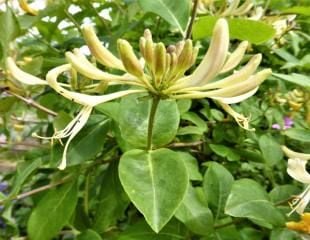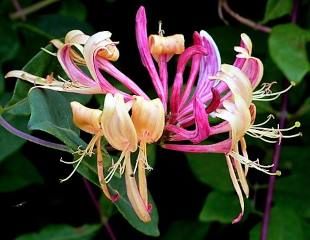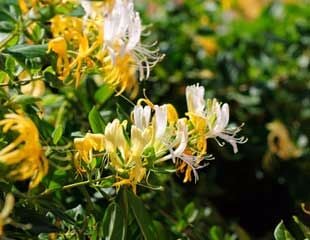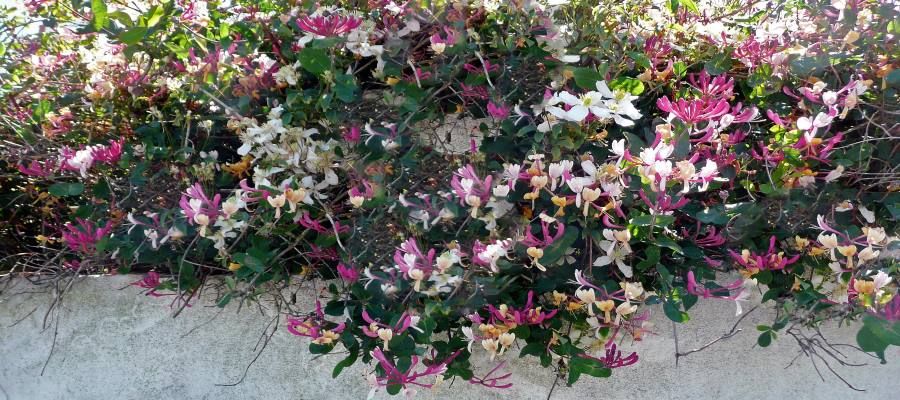


How to grow Lonicera common name Honeysuckle
Honeysuckle is a much-loved garden plant grown for its sweetly scented flowers. It is both a climbing plant and a shrub. It comes from a genus of around 120 evergreen and deciduous shrubs and twining climbers. Honeysuckle is easy to grow, but only in the right spot because it is particular.
The old common name for Honeysuckle was Woodbine, referring particularly to the European Honeysuckle which is Lonicera periclymenum. This tells us the plant's origins are as a woodland plant, which means the right planting spot needs to replicate woodlands where its roots would be in a cool shady area and it would grow towards the light flowering more at the top of the plant. This means to thrive Honeysuckle needs a degree of shade, principally around its roots.
For Honeysuckle, the right place is with its roots in the shade and head and flowers in the sun. This is not easy to achieve and Honeysuckle definitely grows best if planted away from the hottest part of garden. It is very tempting to put Honeysuckle in a sunny spot, perhaps by a fence or covering a wall where, stressed by too much sun and heat, it will almost certainly develop mildew.
Planting areas alongside walls and fences can be dry and over time the Honeysuckle will become straggly and awash with mildew. That said, the image below is of a Honeysuckle growing in Guernsey, looking lovely, cascading over a wall.
When planting a Honeysuckle, it is a good idea to add leaf mould or other organic matter into the planting hole. This will help to retain water, which will help to keep the roots cool. After planting, a good mulch at the roots will help to retain water.
Honeysuckle is good for wildlife, attracting bees and butterflies. Specifically, honeysuckle periclymenum will attract the rare white admiral butterfly, night flying moths and the birds will feed on the berries formed after flowering.

How to Prune Honeysuckle.
Pruning requirements are a little complicated so it is best to keep the label as pruning varies with the different varieties of Honeysuckle.
Climbing honeysuckle, which flowers in the summer such as Lonicera japonica, do not need to be pruned. Simply cut off weedy growth or cut back if it is becoming too large.
For Honeysuckle which flower earlier in the year, cut back after flowering which will be around mid-late summer. Honeysuckle can be quite rampant and any variety which is getting just too large and overgrown can be cut back by about 1/3 after flowering. A good mulch in the spring is ideal.
Prune shrubby Honeysuckle after flowering, which again will be mid to late summer.
The best Honeysuckle to grow
One of the main reasons for growing Honeysuckle is for its scent and so it is important to pick a variety with good scent as not all varieties are as sweet and powerful. There are varieties which look very attractive and will produce good berries, but are not scented such as Lonicera × brownii 'Dropmore Scarlet'. Crocus has over 25 varieties of honeysuckle on sale (affiliate link) including many mentioned here.
The best varieties of Honeysuckle to grow for scent are Lonicera japonica 'Halliana' AGM image left, evergreen or semi-evergreen and a vigorous climber growing to around 10 meters. Note it really is vigorous and in the right place will make a very large climber so best to make sure you have space for it. Many gardeners complain that this variety is more mildew prone.
Another climber is L. periclymenum 'Graham Thomas' AGM which is a good variety, H6 which means it is hardy everywhere in the UK, deciduous, with a good perfume. It is illustrated above right and will reach around 7 meters. This tends to be the most highly praised of Honeysuckle and a good all round choice. Lots of creamy flowers all summer followed by bright berries.
Lonicera periclymenum 'Heaven Scent' which is as the name suggests, is very scented, and a fast growing fully hardy climber. It is more compact reaching around 3 meters.
Of the shrubby varieties, those with scent are L. fragrantissima, which is best grown in a more sheltered spot and flowers in late winter and early spring. Also L. × purpusii ‘Winter Beauty’ a winter flower variety. Both grow to around 2.5-3 meters.
All honeysuckles produce lovely berries which are picked off by the birds in the autumn and winter. The scent of a Honeysuckle is strongest at dusk and is attractive to moths. Ideas for plants which are attractive to bees butterflies and birds
Honeysuckle can be prone to aphids and given their attraction to wildlife it is a shame to spray them. If aphids are a real problem, I tend to use soap and water to wash off the aphids. If blackspot is a problem you can prune off the worst affected after flowering and healthy growth should come back the following year.
Looking for winter scent The Winter flowering honeysuckle, L. fragrantissima, has the sweetest perfume of all, tips and growing advice.
Ideas for more Climbing plants and scented plants
last updated 16.01.2024
